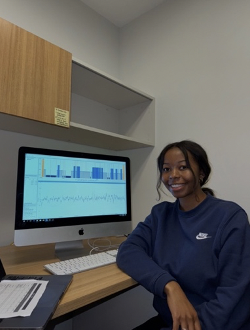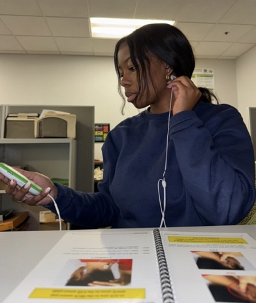Payton McClarity Jones is graduating with the Research Option in Neuroscience. Her thesis, conducted under the direction of Dr. Mark Wheeler, discusses the relationship between problem-solving and sleep.

How long have you been an undergraduate researcher at Georgia Tech?
I have been conducting undergraduate research for 1.5 years at Georgia Tech and 3 years at the Piedmont Cardiology Unit.
How did you get involved with undergraduate research?
Early in my academic career, I got involved in cardiology research by reaching out to upperclassmen conducting research surrounding healthcare. I connected with an upperclassman who was working in a cardiology lab at Piedmont, and she introduced me to the doctor conducting the research. Later in my academic career, I sought more hands-on lab experiences that aligned with my major. So, I contacted my neuroscience and psychology professors and asked about their current research and open positions in their lab.
There was an opening in the psychology lab of Dr. Mark Wheeler, and he welcomed me to join.
What are you working on?
Most of us have moments in our lives when we suddenly realize something. Typically, we call those "aha" moments, but they are formally known as moments of insight. The purpose of my research is to explore the role of sleep, specifically slow-wave sleep (SWS) and REM sleep, in the formation of insight into problem-solving. The experiment uses a portable EEG to monitor participants’ sleeping patterns and the Number Reduction Task to inspire insight. Unlike previous research on the topic, I am conducting this experiment under ethnological sleeping conditions and not in a sleep lab. If slow-wave sleep and REM sleep are mechanistically involved in insight formation the data will display a positive correlation between the rate of post-sleep insight and density of waveforms in SWS and REM sleep. These results will allow researchers to have a better understanding of sleep-related biomarkers that facilitate the formation of insight during problem-solving.

What is your favorite thing about research/researching?
My favorite part of research is designing the experiment. During this step of the scientific process, the researcher has the freedom to manipulate any variable to test correlative relationships, but they must be strategic. Developing the methods is like solving a puzzle that must be tailored to suit the hypothesis and the available resources. I enjoy the challenge of fitting together various components from interdisciplinary perspectives and creating innovative methodologies.
What are your future plans and how has research influenced them?
Throughout my time at Georgia Tech, I have developed a passion for cognitive neuroscience research. I plan to continue pursuing my passion through clinical research in the NIH postbaccalaureate program after graduation. Following the postbacc, I plan to apply what I learn in neuropathology research in medical school.
